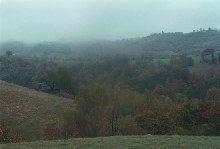In their English monograph, Ivan Vološčuk and a large group of authors present to Europe and the world the national parks and biosphere reserves of the Carpathians as the last natural paradise. An introductory chapter by Vološčuk, in which he provides an overview of the Carpathians, is followed by 28 chapters that are devoted to individual protected areas in five countries.
 |
| Photo: Karin Steinbrueck |
Each chapter deserves its own analysis, but the space available permits me only to give an overview of the national parks (NP) and biosphere reserves (BR) as well as other protected areas according to individual countries: Hungary—Aggtelek (NP and BR), Bukk (NP), Duna-Ipoly (NP); Slovakia—Tatry (NP and BR), Pieneny (NP), Nízké Tatry (NP), Slovenský raj (NP), Malá Fatra (NP), Muránska Planina (NP), Poloniny (NP and BR), Slovenský kras (BR), Polanina (BR), Dobročský prales, Badínský prales, and the proposed national parks Velká Fatra and Horní Orava; Poland—Pieniny (NP) Tatry (NP and BR), Gorce (NP), Magura (NP); Ukraine—Karpatskij zapovidnik (BR), Carpathian National Nature Park (NPP), Sinevir (NPP), Vizhnitskij (NPP), Uzhanskij (NPP), Romania—Retezat (NP).
The individual chapters have been written by highly qualified experts, all of them employees of nature protection areas of the individual countries. The editor has managed to achieve the unbelievable: despite the large number of authors, to maintain a common approach in almost all of the chapters.
They begin with a brilliant photograph of the landscape, which is supplemented by one key species of flower or animal and the protected area's logo. This is followed by a map with sociological zonations and a text that is divided into three sections: Nature, People and Nature, and Nature Conservation. Within a short space the authors have managed to present the chief characteristics of the individual protected areas. Overall, the monograph provides a unique collection of information about the natural environment of the Carpathians, about the influence of human beings and on the history and current state of nature conservation.
The graphic layout of the book is especially attractive and clear for the reader; among the features contributing to easy orientation is the different colored paper, which is used to differentiate the protected areas of different countries. The color photographs (from 36 photographers!) have been well-selected and the printing is excellent (Tlačiareň a vzdavatelĺestvo SLZA, Poprad). I have to admit that it took me a long time to page through and read the book, because the photographs and texts attracted me to those areas I already know and those I have yet to visit.
I think that this book will go down in the history of European nature conservation as a unique example of international cooperation in nature conservation at the end of the 20th century. For this reason, I am disappointed that it does not include the two Carpathian biosphere reserves in the Czech Republic—Pálava and Bílé Karpaty (White Carpathians). Although the map of Carpathian national parks and biosphere reserves on page 8 begins (or ends?) on the territory of the Czech Republic, it is as if the Moravian protected areas did not exist.
Furthermore, the text notes that the Western Carpathians are "spread over the territory of Bohemia..." (p 9). The translator should note that the most western reaches of the Carpathian range lie in Moravia, which is now a part of the Czech Republic. The Moravian areas that have been omitted do not lessen the value of this publication, but rather present a challenge to Moravian nature conservationists to become actively involved in international cooperation in the Carpathians so that in future they cannot be overlooked.
I propose to the editor that he consider publishing a chapter about both Moravian biosphere reserves in the Carpathians as a supplement, thus bringing the work to full perfection.
Antonín Buček, 23 April 2001
Antonín Buček is professor of forestry at Masaryk University in Brno, Czech Republic. This review article first appeared in the January 2001 issue of VERONICA (vol. 15/no.1), the bi-monthly magazine of Czech nature conservationists, published since 1986. Contact information: www.veronica.cz, veronica@ecn.cz.
Translation by Andreas Beckmann
Moving on:





